If your ideal aquarium includes an abundance of energy, then the tiger barb is the fish for you!
These highly active fish have boisterous personalities to match, which makes them fun to own.
It also makes it a little challenging to pair them with ideal tank mates. Rest assured, these fish do quite well when paired with the right species and in the right tank setup.
Puntigrus tetrazona are considered semi-aggressive fish.
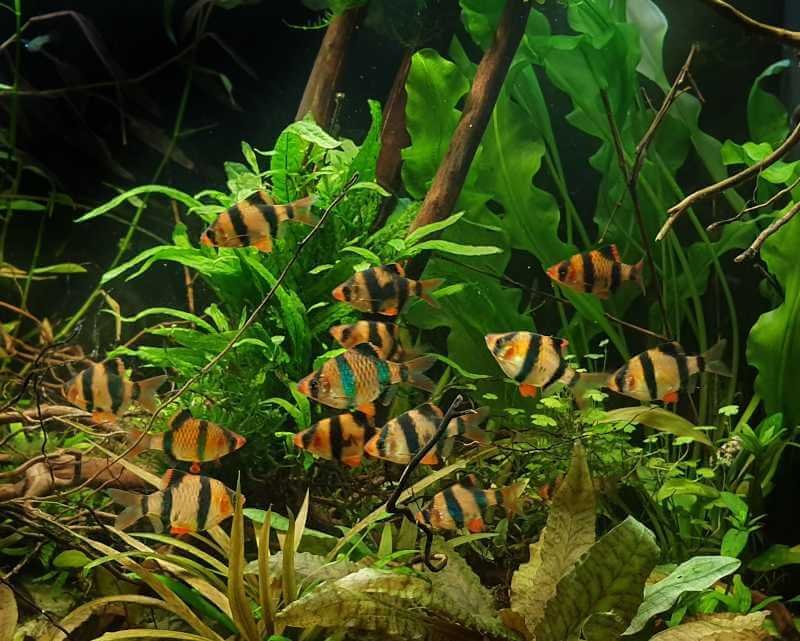
They demonstrate hierarchical aggression amongst themselves, often chasing and bumping each other in a quest to establish dominance.
This aggression can sometimes extend to others in the tank, resulting in some bullying and fin nipping of smaller, slower, or long-finned fish.
Set Up Your Tank for Success
There are ways to temper this aggressive tendency by keeping a large enough school of tiger barbs in a large enough tank.
School and Tank Size
Tiger barbs are a species that cannot be kept as a single specimen and are a little picky when it comes to group size.
In fact, a group that is too small or too large is enough to stress them and contribute to aggression.
At least eight fish and no more than 12 seem to be ideal.
Finally, keep your fish in an aquarium no smaller than 30 gallons (114 l) to allow adequate swimming space.
Decorations
Include plants that grow into the middle levels of the tank, where the tiger barbs tend to hang out.
Although this active species spends most of its time in the open, they will appreciate added driftwood, rocks, or caves on the bottom to give plenty of hiding places when needed.
Water Parameters
Select tank mates that are compatible with the tiger barb’s water parameters.
Fortunately, this fish has a wide tolerance range, which is one of the reasons they are found in so many places in the wild.
Tank mates for the tiger barb should be comfortable in the following water conditions:
- Temperature: 68 to 82F (20-28C), mid to upper 70s is best
- pH: 6.0 to 8.0, slightly acidic 6.5 is best
- Hardness: 4 to 10 dKH.
Selecting Tank Mates for Tiger Barbs

When shopping around for tank mates for your tiger barb, look for:
- Fast swimming fish
- Fish that grow to around the same size, 2.5 to 3 inches (6.4-7.6 cm)
- Similar water parameter needs between the species.
Avoid the following:
- Smaller fish
- Fish that need a calm environment
- Long-finned or slow-moving fish
- Be careful with shrimp, as your barbs may harass them (snails, however, should be fine).
Add the tiger barbs to an established tank last for best results. Adding other fish to a tiger barb tank may result in aggression as the barbs can be territorial.
Below, we have listed several excellent companions for your tigers. Take a look and see which ones interest you!
Recommended Tiger Barbs Tank Mates
1. Cherry Barb (Puntius titteya)

Minimum Tank Size: 25 gallons
Cherry barbs are a good standby to pair with tigers. Not only do they love the same water parameters, their quiet personalities and excellent tank mate tolerance make them a sensible choice.
As an added bonus, these active schooling fish have a bright red color that is irresistible as they dart through the middle region of the tank.
They grow to around the same length as your tigers, so you should not have to worry about bullying between the species.
Cherry barbs love a well-planted tank with ample vegetation yet plenty of swimming space.
2. Siamese Algae Eater (Crossocheilus oblongus)

Minimum Tank Size: 20 gallons
Pairing tiger barbs with peaceful bottom dwellers makes sense, and the Siamese algae eater (SAE) is an excellent candidate.
This fish is an extraordinary algae consumer and highly active, always looking for the next snack.
You do not need to keep a specific group size for this species, which allows flexibility in tank composition.
Basically, if you have the right number of tiger barbs, then the SAE should get along with them.
They reach up to six inches (15 cm) in length, so make sure the tank size can accommodate both species, and produce a fair amount of waste, so do not overstock.
3. Platies (Xiphophorus)

Minimum Tank Size: 10 gallons
Platies are peaceful, colorful fish that tend to get along well with tiger barbs.
They are active swimmers and need sufficient space to be healthy. Keep a large enough tank to account for the school sizes needed by your tigers.
While water parameters match well, keep the hardness on the lower end of the platy’s range where it overlaps with the tiger’s.
Compatibility may be improved by raising the barbs and platies together.
Keep your platies in a ratio of two or three females for every male to reduce competitive aggression.
4. Odessa Barb (Pethia padamya)

Minimum Tank Size: 30 gallons
The Odessa barb loves the same heavily vegetated, slightly acidic waters as do tiger barbs.
They are active swimmers and schooling fish that are comfortable exploring all levels of the tank. These fish reach the same adult size as your tigers and their coloration is amazing.
Keep Odessa barbs in a group of at least five so they feel confident, peaceful, and content.
Your tigers are not likely to nip at the Odessa and vice versa.
These two species have similar dietary needs, so feeding time is simple. Offer a healthy variety of foods to keep them at their best.
5. Mollies (Poecilia sphenops)

Minimum Tank Size: 10 gallons
Mollies work well with tiger barbs if several conditions are met.
Both species have aggressive tendencies, so strive to set up the best environment possible.
Start with a good-sized, established tank with plenty of swimming space and stable water parameters.
Adhere to the recommended group sizes for each species. Mollies need a group of at least four.
Always keep a higher number of female mollies to males. Even in a stable tank, both species can occasionally fin nip.
Choose the short-finned molly variation so as not to provide a tempting target for the tiger barb.
6. Black Ruby Barb (Pethia nigrofasciata)

Minimum Tank Size: 30 gallons
The black ruby barb is an elegantly colored, hardy species from southern India.
Like the tiger barb, their native waters contain dense vegetation and are slightly acidic.
Keep the pH toward the lower end of the tiger’s range to better overlap with the black ruby’s.
Black rubies are slightly smaller than your tiger, reaching only two inches in length (5 cm), but the size difference should not pose any issues.
They are peaceful and not as nippy as tigers. Keep them in a group of at least eight, and they will mind their own business exploring the bottom and middle levels of the tank.
7. Red Spotted Severum (Heros efasciatus)
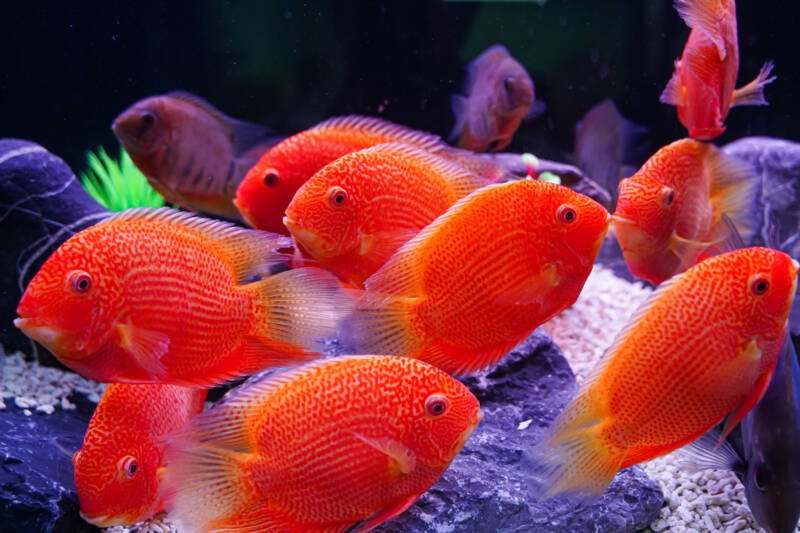
Minimum Tank Size: 55 gallons for a single fish
Severums originated in South America but is bred in captivity to produce its beautiful coloration.
Although they grow to a large size of 10 inches (25 cm), this species pairs well with your tiger barbs because it is less aggressive and only becomes territorial when breeding.
Plan on a tank size of at least 100 gallons (379 l) to give plenty of space for each species and include a cave in which your severum can shelter.
Keep the pH and hardness toward the lower end of the tiger’s tolerance as the severum prefers more acidic and softer waters.
8. Apistogramma Dwarf Cichlid (genus)
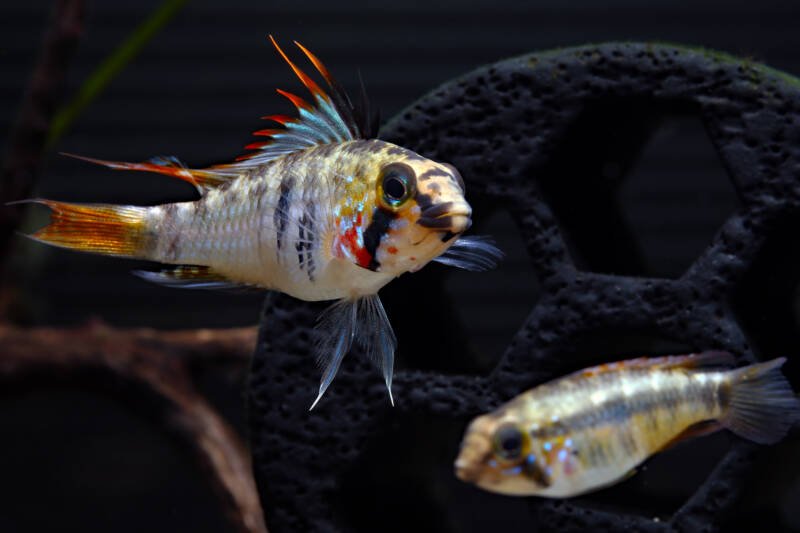
Minimum Tank Size: 20 gallons
If you are looking for a cichlid, but do not want the large size, then consider the apistogramma dwarf cichlid.
There are over 90 species in this genus, ranging in size from 0.8 to 3.1 inches (2-7.9 cm) in length.
Choose a larger species to better match the tiger barb’s size.
These fish prefer the bottom of the water column, which eliminates territorial squabbles with the tigers.
Avoid keeping multiple apistogramma males in the same tank, as they may get ornery.
Keep either a bonded pair or a male with several females.
In some species, the males have long dorsal fins, which your tigers may find tempting.
9. Cory Catfish (Corydoras)
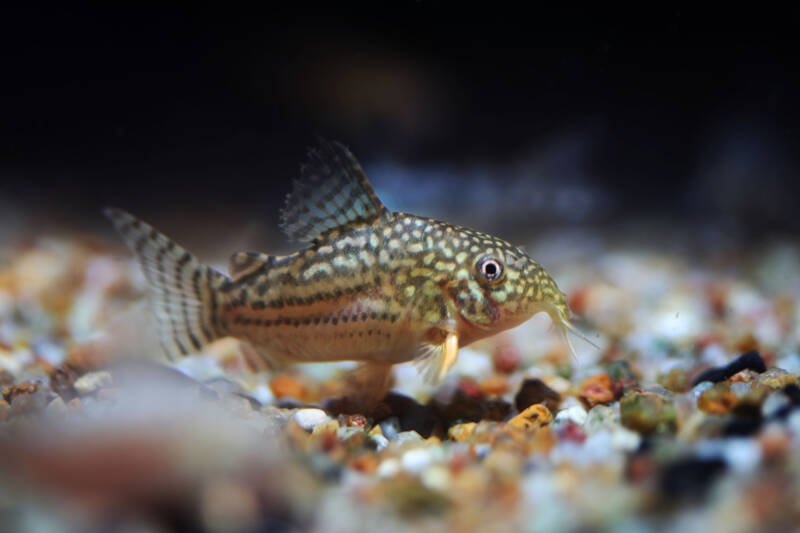
Minimum Tank Size: 10 gallons
Ah, the dependable cory catfish! So often recommended as an ideal resident in community tanks, the cory should be paired with caution when it comes to tiger barbs.
This is a case where the individual personalities of the barbs matter.
Although the cory has some protection from its “armor,” they are slow swimmers.
If your tigers take to picking on it, your catfish may come out on the losing side.
Keep your tigers are in a suitable group, have a large tank, and a group of four to six corys for the best results.
10. Otocinclus (genus)

Minimum Tank Size: 10 gallons
Otocinclus are small, passive bottom dwellers that get along with their tank mates and are a great part of a cleanup crew.
There are 20 different dwarf species from which to choose. Because they favor the bottom, they should not get in the way of your tigers.
These armored catfish have some protection should your tigers get curious and should be kept in a group of four to six.
They love the exact same water conditions as your tiger barbs.
Include a soft substrate and multiple hiding places along the bottom that your otos can zip into if frightened.
11. Common Plecostomus (Hypostomus plecostomus)
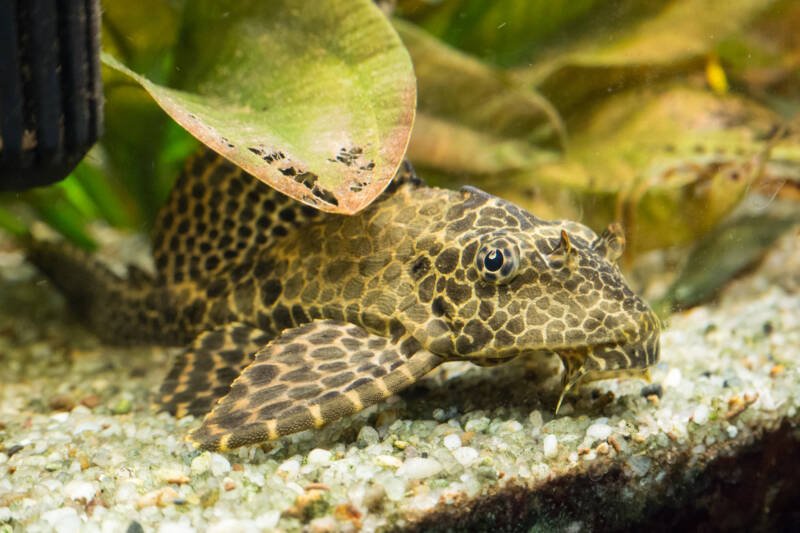
Minimum Tank Size: 75 gallons
Another armored catfish, the common pleco is a relaxed bottom-dweller well into their juvenile stage.
Once they reach adulthood, they are somewhat territorial and can be housed with other semi-aggressive species, such as the tiger barb.
These fish tolerate a huge range of water parameters and will be most active when your tigers are at rest.
The downside: these fish get big – anywhere from 15 inches (38 cm) up to two feet (61 cm) in length – and need a sizable tank.
They also produce a large amount of waste. Make sure your filtration system can handle both the size of the tank and the amount of waste the pleco produces.
12. Silver Dollar (Metynnis argenteus)

Minimum Tank Size: 75 gallons
The silver dollar is a plant-eating, peaceful fish from the same family as the piranha.
This active swimmer favors the top of the water column, bringing sparkle to the tank with its glittering scales.
They grow larger than your tiger barb, with a maximum length of six inches (15 cm), and need a school of at least five.
You may see fin nipping by the tiger barbs but keeping adequately sized schools for each species should help.
The water parameters for each species match well but do not exceed a pH of 7.0 for optimal silver dollar health.
Fortunately, a pH of 6.8 is perfect for your tiger barbs.
13. Kuhli Loach (Pangio kuhlii)
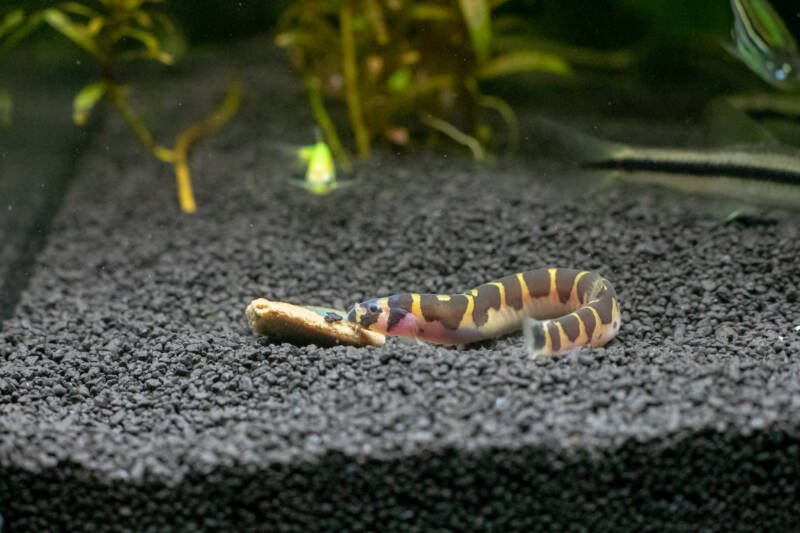
Minimum Tank Size: 15 gallons
Kuhli loaches hide during the day and are active at night, keeping them out of the way of your tiger barbs.
This species is a bit shy and will slip into a hiding place if they feel threatened.
Keep at least three loaches in a group to increase their confidence.
When feeding your fish, add both sinking and floating foods simultaneously to ensure the tiger barbs do not consume all the food before it reaches your loaches.
Keep up the water quality as kuhli loaches are susceptible to disease if tank conditions are poor.
14. Swordtails (Xiphophorus helleri)
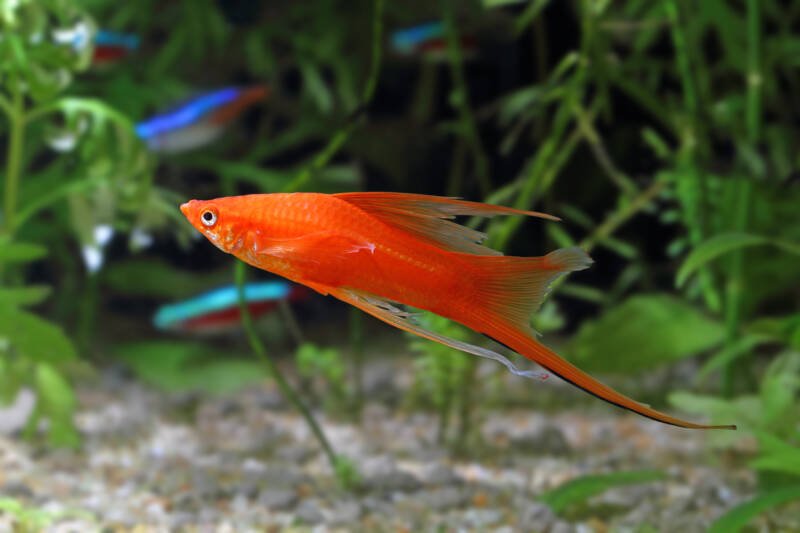
Minimum Tank Size: 15 gallons for a single fish
With a fin nipping species like the tiger barb, you would not expect the swordtail to be on the list, but they are compatible if several conditions are met.
First, make sure the tank is large. Both species can be temperamental, and nothing will prompt aggression faster than confined living space.
Second, keep the recommended group sizes for both swordtails and tigers. This will better encourage each species, especially the tiger barbs, to keep to themselves.
Limit the number of swordtail males and keep a one to four ratio of males to females.
15. Tinfoil Barbs (Barbonymus schwanenfeldii)
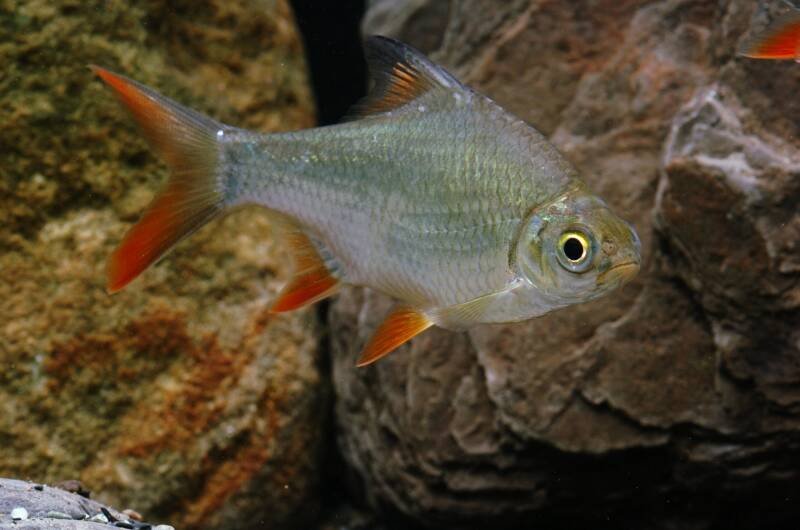
Minimum Tank Size: 75 gallons for a single fish
Tinfoil barbs are a mesmerizing sight when swimming together in a school.
These large but gentle fish grow to 14 inches (36 cm) in length, and a group of at least six will need a sizable tank to accommodate their energetic and fast swimming.
Their high activity level is fine for the equally active tiger barbs, their water parameters match well, and they tend to occupy the same areas of the water column.
Tinfoils can eat live plants and smaller fish. Do not introduce very small tigers to the tank or you risk losing them.
16. Black Skirt Tetra (Gymnocorymbus ternetzi)
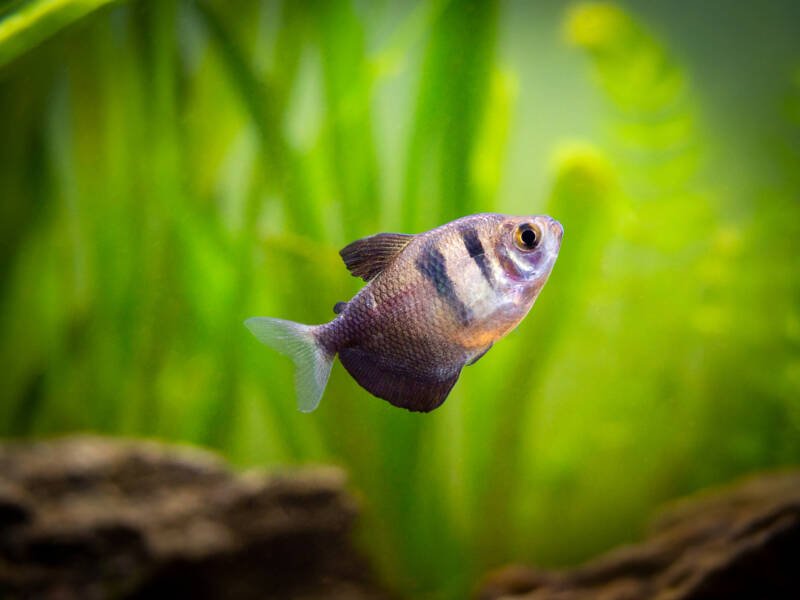
Minimum Tank Size: 15 gallons
Black skirt tetras are active, easy to care for, and need plenty of dedicated space.
Their favorite location in the tank is the middle level.
These fish grow to a length of three inches (7.6 cm), which is compatible with your tigers, and prefer a school of at least five.
The easy-going nature of these fish makes them excellent partners for your tigers.
The funny thing is, the black skirt tetra is a fin nipper for other long-finned species, yet their own flowing fins may be a tempting target for your tigers. Keep an eye on interactions within the tank.
17. Bolivian Ram (Mikrogeophagus altispinosus)

Minimum Tank Size: 30 gallons
Mixing the feisty tiger barb with a cichlid might seem like a bad idea, but the Bolivian ram is relatively calm.
Keep it in a group of at least six, and their temperament is even better.
You may see some territorial guarding when the rams are ready to breed.
The three-inch-long (7.6 cm) Bolivian ram favors the bottom to middle areas of the tank and thrives in the same water conditions as the tiger barb.
They love to swim just as much as barbs do, so go with a larger tank if possible.
Bolivian rams have longer fins, so keep an eye out for any nipping by your barbs.
18. Zebra Loach (Botia striata)

Minimum Tank Size: 30 gallons
Who wouldn’t want to say they have a tank full of tigers and zebras?
The zebra loach, once plentiful in western India, is endangered in the wild due to habitat loss and pollution. Make sure that the fish you purchase has been bred in captivity.
Size-wise, zebras match well with the tiger barb, coming in at three to four inches (7.6-10 cm) fully grown.
Keep them in a group of at least five to show their best behaviors; lower numbers can lead to aggression.
Zebras will alternate their time between hiding out and peacefully cruising the bottom of the tank.
19. Red Tail Shark (Epalzeorhynchos bicolor)
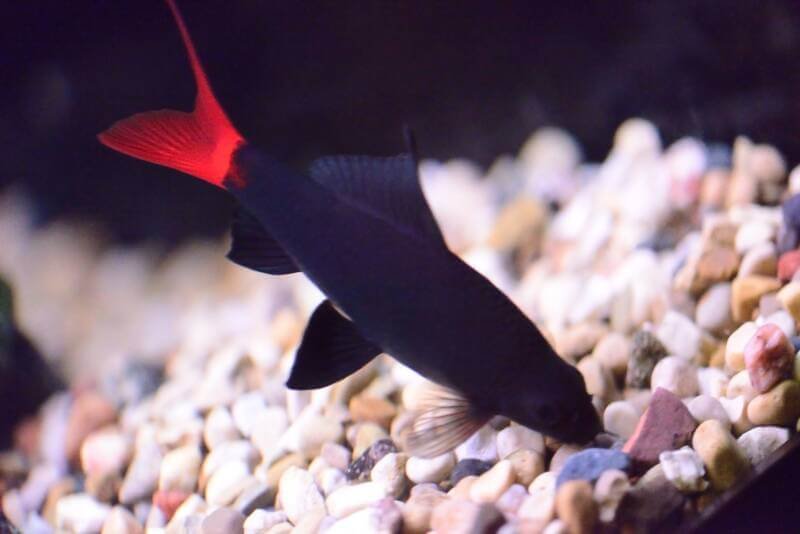
Minimum Tank Size: 55 gallons
The red tail shark originated in Thailand and is critically endangered in the wild.
Thriving in aquariums, these fish are active swimmers and need lots of space to explore.
Like the rainbow shark, the red tail reaches a length of six inches (15 cm) and is best kept as a single specimen, unless you plan to increase the tank size significantly.
Anything smaller will increase the red tail’s territorial aggression.
Water parameters match well between the red tail and tiger barb but keep the hardness toward the lower end of the red tail’s range to ensure overlap with the tiger’s.
20. Yo-yo Loach (Botia almorhae)
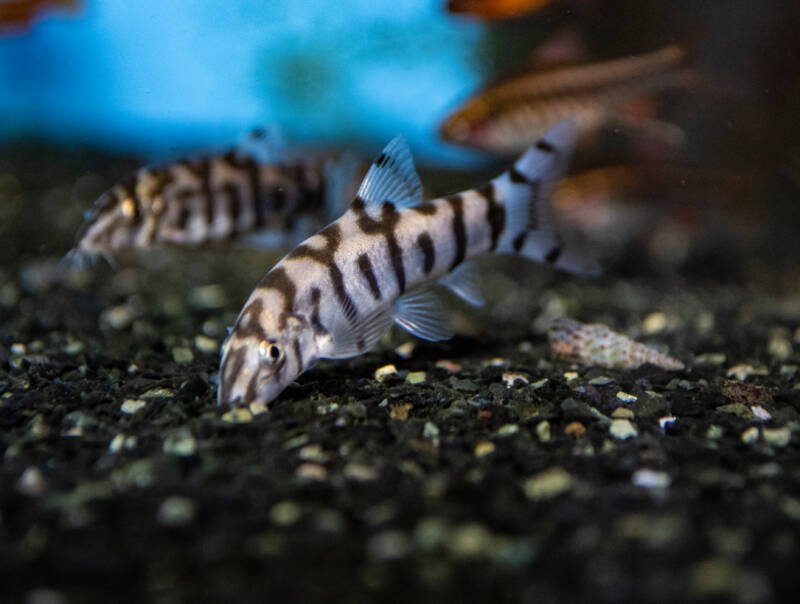
Minimum Tank Size: 40 gallons
Yo-yo loaches are one of the more active loach species you can get.
This, combined with an easy matchup of water parameter needs, makes them a great companion for your tiger barb.
Yo-yos move around during the day, traversing all levels of the water column, but pretty much mind their own business.
These natives to northern India and Nepal stay small, reaching 2.5 inches (6.4 cm) in length as adults, but still, need a large tank to accommodate their need for space.
Keep them in a group of four to five for their best behavior.
21. Rainbow Shark (Epalzeorhynchos frenatum)
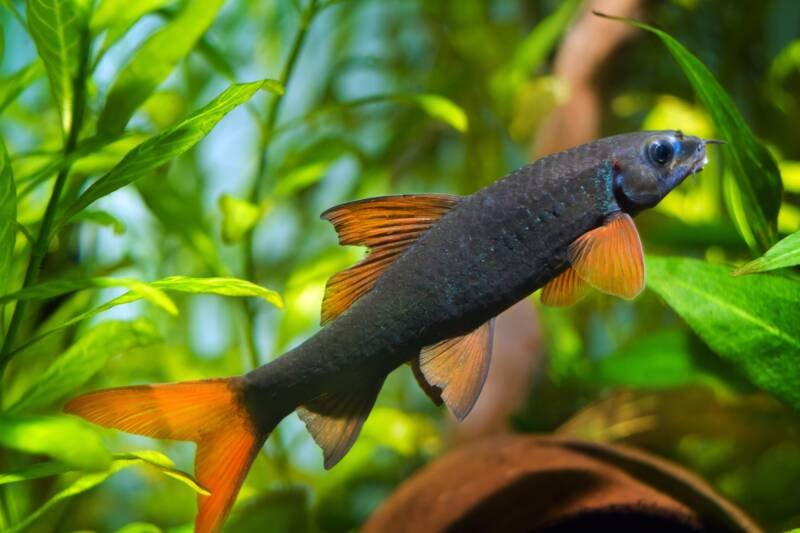
Minimum Tank Size: 55 gallons
Pair these species with caution. Both have semi-aggressive natures, and you will need a large, well-planted tank with plenty of rocks along the bottom.
That said, the energetic rainbow shark sticks to the bottom of the tank, while the tigers prefer the middle, reducing territorial conflict.
Keep the rainbow shark as a single specimen or in a group of at least five for the best results.
This fish grows to six inches (15 cm) in length, so plan on a 125-gallon tank if keeping a group.
Avoid keeping multiple males due to territorial squabbles and do not house them with similar fish, such as the red tail shark.
Closing Thoughts
The overwhelming consensus is that although tiger barbs have a reputation for being slightly territorial fin nippers if you set them up for success from the start, you have many choices with which to pair them in a community tank.
Pay attention to tank size, school size, and stable water parameters, and the result will be a fun and active aquarium.
Join the conversation! Tell us your stories about keeping tiger barbs.
What are your favorite pairings?